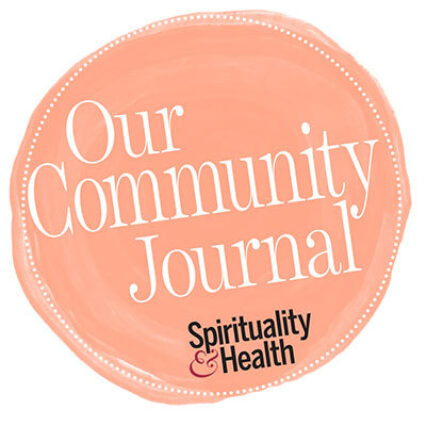My Two-Hour Hug Fest
Good to See You by Andrea Caballero Salcido
The lumberjack of a stranger and I embraced like old friends after a long absence. His awkward smile mirrored mine as we released each other, but I was surprised by my sense of euphoria.
The “hug fest” at a local strip mall was something I’d agreed to help organize because I supported the project’s mission of drawing attention to the growing epidemic of loneliness. But I’d been hesitant. After all, in our isolated suburban world, would the invitation to embrace a stranger come across as intrusive, or downright creepy? Then there was the other reason for my apprehension.
My mother had instilled the need to keep my distance from strangers, exemplified most terrifyingly by that classic boogeyman, the driver proffering a tempting candy bar. So effective were my mother’s admonitions that if a man even drove past on our neighborhood road, I’d scramble as far away from the potential threat as possible, scraping my legs on the bramble bushes lining the sidewalks.
But strangers in cars were not the only menace. The introduction of the Peace Offering during the Catholic Mass in the 1960s horrified my reserved mother, who instructed her children to interact as little as possible with any person attempting to shake our hands. “Fiddle with your rosary beads, read your hymnal, stare at the Virgin Mary,” she warned. “Don’t let that stranger touch you.”
So to please my mother, I erected an invisible wall between me and anyone with the gall to offer an outstretched hand. I didn’t grasp the power of this simple gesture then, or how it served to strengthen human connection. Nor did I understand that my family was lacking something.
It wasn’t until I dated my future husband, Jimmy, that my aversion to touch began to subside. His large Greek-American family was physical and loving, hugging and kissing hello and parting over endless embrace, a phenomenon dubbed “The Long Greek Goodbye” by other non-Greek spouses in the family. Jimmy’s relatives adored each other, and though they were prepared to adore me, too, I was my mother’s daughter, anxious about the invasion of personal space. Still, I recognized that if I wanted to join this loving Hellenic dynasty, my familial training needed to be undone. It took a few years of awkward practice before I stopped transforming into a ragdoll when receiving their affections; but I learned to return, and even look forward to, the warm hugs showered on me.
Now, at the strip mall, I understood for the first time what had eluded my mother all those years: the power of a stranger’s touch to generate well-being—a truth many of the people who passed us that day seemed to comprehend. Most people that we approached with our “free hugs” signs eagerly took us up on the offer, even thanking us for brightening their day. Others hurried past with a polite “No, thank you,” or kept their heads down, looking alarmed.
I recognized my former self in them, a woman who had learned to enjoy hugs from family but avoid physical contact from strangers. When a friend once asked me to stand in line with her to receive hugs from a famed Indian spiritual healer, I declined out of discomfort. Now I’d welcome the chance.
The morning after the hugathon, I woke up awash in happiness, as though I’d won the lottery. Later that day, I remembered research I’d discovered while planning the event: an embrace lasting only 20 seconds releases oxytocin, a neurochemical that produces feelings of bliss and contentment. How many hugs did I hand out yesterday? Nearly 20? I’m positive the power of touch produced my feelings of elation. Funny—I had to learn from strangers outside a suburban strip mall something my loving Greek in-laws knew and had been demonstrating to me all along.
10 Steps to a Hugathon
- Choose a place with lots of foot traffic: strip malls, shopping centers, farmers’ markets, waterfronts, downtown parks, or arts festivals.
- Get permission from the property owner, festival organizers, or the closest business.
- Plan at least six weeks in advance. Select a rain date if there is no protected overhang. Choose a short time frame, such as two or three hours. Line up two to four huggers, or more.
- Learn the stats on the size of the loneliness epidemic and on the health benefits of hugging.
- Send press releases to news outlets. Post on social media. Announce at community meetings. Put up flyers.
- Create signs that read “Free Hugs” and handouts such as tiny cards with inspirational quotes.
- Be upbeat and welcoming. Call out to passersby, “Want a free hug?” or “Want a free inspirational quote?” Develop the art of the “warm up.”
- Understand that most people will say “yes” or venture closer to test the hugging waters. Encourage conversation on the topic of connection. Thank everyone who stops by.
- Respect those that say “no.” Give all rejections an air hug. Take breaks.
- Relish the experience. Enjoy the oxytocin natural high. Share your joy.

Share Your Story
Welcome to Our Community Journal — S&H’s new platform to swap insight and inspiration within our community of readers.
We’re looking for personal essays, written in your unique voice and style, offering wisdom from your journeys of emotional and physical healing, spiritual awakening, and joy.
Selected stories are shared in print and online, and promoted to our social media audience of over 300,000 people!
Read the latest stories and view submission guidelines at spiritualityhealth.com/OurCommunityJournal

